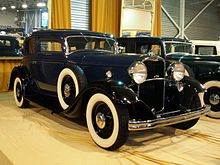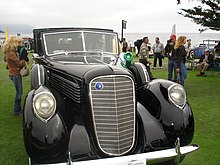Lincoln K series
| Lincoln K series | |
|---|---|
 1937 Lincoln Model K Brunn Touring Cabriolet | |
| Overview | |
| Manufacturer | Lincoln (Ford) |
| Also called | Lincoln Model K |
| Model years | 1931–1940 |
| Assembly | Lincoln Assembly, Detroit, Michigan, U.S. Long Beach Assembly, Long Beach, California, U.S. |
| Designer | E.T. (Bob) Gregorie Edsel Ford |
| Body and chassis | |
| Class | Luxury car |
| Powertrain | |
| Engine | 385 in³ (6.3 L) Lincoln L-head V8 448 in³ (7.3 L) Lincoln L-head V12 engine V12 382 in³ (6.3 L) Lincoln L-head V12 engine V12 414 in³ (6.8 L) Lincoln-Zephyr V12 engine V12 |
| Transmission | 3-speed manual[1] |
| Dimensions | |
| Wheelbase | 136 in (3454 mm) 145 in (3683 mm) |
| Chronology | |
| Predecessor | Lincoln L series |
| Successor | Lincoln H series |
The Lincoln K series (also called the Model K, reflecting the earlier Ford Model K) was a line of luxury vehicle produced by Lincoln from 1930 to 1940. While the original K series featured a 385 in³ (6.3 L) V8, a V12 became standard in 1933. Customers also had the choice of ordering a fully custom coachwork.
1931

The original Model K appeared in the 1931 model year on a new chassis with a 145 in (3683 mm) wheelbase. Factory bodies included two- and four-door phaetons, the latter available as a dual-cowl model. The 384.8 in³ (6.3 L) engine was a derivative of the earlier L-series 60° V8, but a dual venturi downdraft Stromberg carburetor, higher compression, and altered timing raised the power to 120 hp (89 kW). It competed with the recently introduced Chrysler Imperial, Rolls-Royce Phantom II, Mercedes-Benz 770, Duesenberg Model J, Packard Eight, and the Cadillac Series 355.
1932

The Lincoln K series was split in 1932 into two lines, the V8 carryover Model KA and the new V12-powered Model KB. The V8 car reverted to a 136 in (3454 mm) wheelbase, though engine output was pushed to 125 hp (93 kW). The KB, on the other hand, featured the marque's new L-head V12 engine. The 447.9 cuin (7.3 L) 65° L-head unit produced 150 hp (112 kW).[2] Both series featured a new grille with less of a surround, vent doors rather than vertical louvers on the sides of the hood, a parking light on top of each front fender, and 18 inch wire wheels. The Lincoln V-12 competed directly with cross town rival Cadillac V-12 introduced earlier in 1930, and it joined a select group of 1930s cars with multicylinder engines, namely those manufactured by Franklin, Hispano-Suiza, Horch, Lagonda, Maybach, Packard, Rolls-Royce, Tatra, Voisin, Walter, and Marmon. The Victoria Coupe was offered as both a steel roof and a convertible, and the coupe was the inspiration for the smaller 1932 Ford Victoria coupe, also offered with a V8 engine but a more affordable price.[3] The Lincoln Victoria coupe, first introduced in limited numbers in 1929,[4] also competed with the Packard Light Eight Victoria coupe also in 1932.
1933
The V8 engine was replaced in the Model KA with a new 381.7 in³ (6.3 L) V12 for 1933. This L-head engine shared little with the big KB engine which continued unchanged.
The 1933 K-series Lincolns featured many changes, only a few of which were readily visible. The removal of the bar linking the headlights and return of hood louvers was most noticeable, but the revised chassis, thermostatic shock absorbers, and transmission made the greatest difference. Drivers would notice the adjustable-pressure brakes.
1934
Both V12 engines were replaced for 1934 by a single 414 in³ (6.8 L) version of the new Model KA V12, with the KA and KB names now denoting the wheelbase only. Styling changes included a body-colored grille surround and the replacement once again of louvers with doors on the side of the hood.
1935
The Lincoln line was greatly trimmed for 1935, with all cars simply called Model K. The marque attempted to improve profitability by focusing on the lofty over-$4,000 segment, limiting sales in the depression-wracked United States.
1936
The Model K's days were numbered as the less-expensive and more-modern Lincoln-Zephyr debuted for 1936. A 7-passenger Model K limousine was the marque's best-selling model despite its $4700 price, however. The grille and front fascia were again redesigned, and a revised raked windshield and pressed steel wheels were now used.
1937–1940


The Model K continued in production for five more years, but sales declined rapidly with the modern Zephyr and new flagship Continental being more appealing to buyers. Production was evidently completed during the 1939 model year. The last Lincoln K series was delivered in January 1940. The "Sunshine Special" convertible limousine built for President Franklin Delano Roosevelt in 1939 was modified in 1942 with current Lincoln front sheetmetal.
Sources
- ^ Kimes, Beverly (1996). standard catalog of American Cars 1805-1942. Krause publications. ISBN 0-87341-428-4.
- ^ "329", Greenwich Concours d'Elegance Auction (Auction Catalogue), New York, NY: Bonhams & Butterfields Auctioneers, 2013-06-02, p. 94, Sale Number 21153
- ^ "Lincoln Series KA Victoria coupe". Desert Classics. Retrieved 28 March 2017.
- ^ "1929 Lincoln Victoria LeBaron coupe". Significant Cars.com. Retrieved 30 March 2017.
- David L. Lewis (2005). 100 Years of Ford. Publications International. ISBN 0-7853-7988-6.
- "1936 Lincoln Model K Series 300". Retrieved August 21, 2006.
